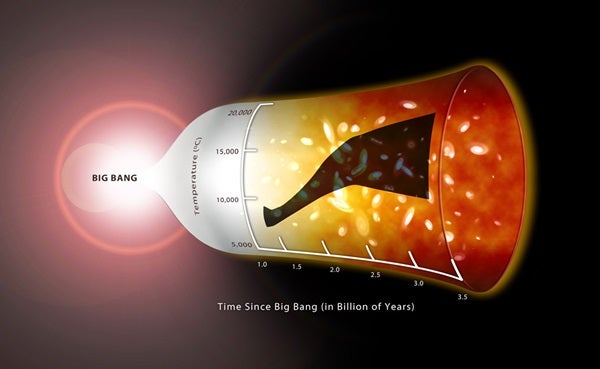“Early in the history of the universe, the vast majority of matter was not in stars or galaxies,” said George Becker from the University of Cambridge in England. “Instead, it was spread out in a very thin gas that filled up all of space.” The team, led by Becker, was able to measure the temperature of this gas using the light from distant objects called quasars. “The gas, which lies between us and the quasar, adds a series of imprints to the light from these extremely bright objects, and by analyzing how those imprints partly block the background light from the quasars, we can infer many of the properties of the absorbing gas, such as where it is, what it’s made of, and what its temperature is.”
The quasar light the astronomers were studying was more than 10 billion years old by the time it reached Earth, and had traveled through vast tracts of the universe. Each intergalactic gas cloud the light passed through during this journey left its own mark, and the accumulated effect can be used as a fossil record of temperature in the early universe. “Just as Earth’s climate can be studied from ice cores and tree rings,” said Becker, “the quasar light contains a record of the climate history of the cosmos.”
“Of course, the temperatures we measured are a bit different from what you find on Earth,” Becker said. “One billion years after the Big Bang, the gas we measured was a ‘cool’ 14,400° Fahrenheit (8,000° Celsius). By 3.5 billion years, the temperature had climbed to at least 21,600° F (12,000° C).”
Scientists believe the warming trend runs counter to normal cosmic climate patterns. Normally, the universe is expected to cool down over time. As the cosmos expands, the gas should get colder, much like gas escaping from an aerosol can. To create the observed rise in temperature, something substantial must have been heating the gas.
“The likely culprits in this intergalactic warming are the quasars themselves,” said Martin Haehnelt from Cambridge University. “Over the period of cosmic history studied by the team, quasars were becoming much more common. These objects, which are thought to be giant black holes swallowing up material in the centers of galaxies, emit huge amounts of energetic ultraviolet light. These UV rays would have interacted with the intergalactic gas, creating the rise in temperature we observed.”
One of the lightest and most abundant elements in these intergalactic clouds, helium, played a vital role in the heating process. Ultraviolet light stripped the electrons from a helium atom, freeing the electrons to collide with other atoms and heat up the gas. Once the supply of fresh helium was exhausted, the universe started to cool down again. Astronomers believe this probably occurred after the cosmos was one-fourth of its present age.
“Early in the history of the universe, the vast majority of matter was not in stars or galaxies,” said George Becker from the University of Cambridge in England. “Instead, it was spread out in a very thin gas that filled up all of space.” The team, led by Becker, was able to measure the temperature of this gas using the light from distant objects called quasars. “The gas, which lies between us and the quasar, adds a series of imprints to the light from these extremely bright objects, and by analyzing how those imprints partly block the background light from the quasars, we can infer many of the properties of the absorbing gas, such as where it is, what it’s made of, and what its temperature is.”
The quasar light the astronomers were studying was more than 10 billion years old by the time it reached Earth, and had traveled through vast tracts of the universe. Each intergalactic gas cloud the light passed through during this journey left its own mark, and the accumulated effect can be used as a fossil record of temperature in the early universe. “Just as Earth’s climate can be studied from ice cores and tree rings,” said Becker, “the quasar light contains a record of the climate history of the cosmos.”
“Of course, the temperatures we measured are a bit different from what you find on Earth,” Becker said. “One billion years after the Big Bang, the gas we measured was a ‘cool’ 14,400° Fahrenheit (8,000° Celsius). By 3.5 billion years, the temperature had climbed to at least 21,600° F (12,000° C).”
Scientists believe the warming trend runs counter to normal cosmic climate patterns. Normally, the universe is expected to cool down over time. As the cosmos expands, the gas should get colder, much like gas escaping from an aerosol can. To create the observed rise in temperature, something substantial must have been heating the gas.
“The likely culprits in this intergalactic warming are the quasars themselves,” said Martin Haehnelt from Cambridge University. “Over the period of cosmic history studied by the team, quasars were becoming much more common. These objects, which are thought to be giant black holes swallowing up material in the centers of galaxies, emit huge amounts of energetic ultraviolet light. These UV rays would have interacted with the intergalactic gas, creating the rise in temperature we observed.”
One of the lightest and most abundant elements in these intergalactic clouds, helium, played a vital role in the heating process. Ultraviolet light stripped the electrons from a helium atom, freeing the electrons to collide with other atoms and heat up the gas. Once the supply of fresh helium was exhausted, the universe started to cool down again. Astronomers believe this probably occurred after the cosmos was one-fourth of its present age.










